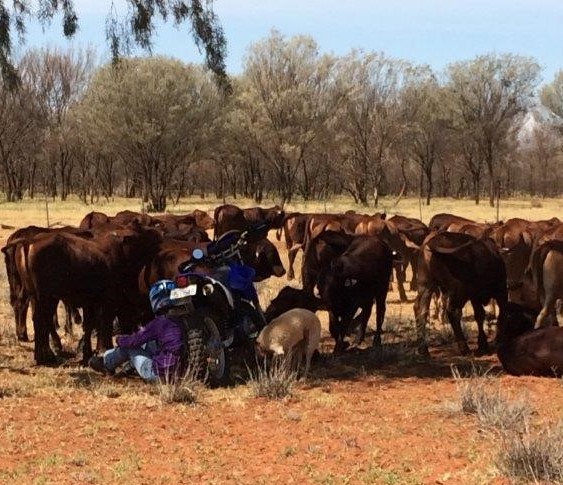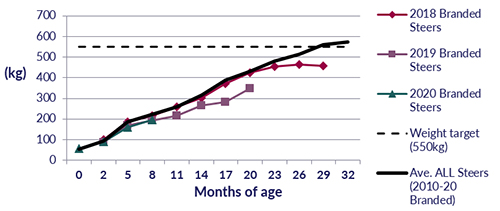Pastoral Research Station Herd Performance report for 2019 to 2020
The Northern Territory Government’s cattle research and management program is integrated across two agricultural research stations near Alice Springs, Old Man Plains Research Station (OMP) and the Arid Zone Research Institute (AZRI).
OMP is 525km2 (includes Quarantine and Borefield areas) while AZRI is 6.5km2. The cattle herd at AZRI has 30 heifers used as sentinels for arboviruses (monthly blood tests). The larger herd at OMP is used for research projects. Quality Graze is a long-term grazing strategies project that determines which animals are allocated to each paddock at any point in time. These include steers, breeders and calves. Bulls spend three months with the breeders for controlled mating and are in their own paddocks for the rest of the year. Most of the bulls are bred on property.
The Research Station Herd Performance report is an annual cattle production summary that celebrates our successes and highlights areas for improvement.
The season
Rainfall for the 2019 to 2020 period was low across OMP and AZRI, with 12-month totals ranging from 50 to 120mm.
In May 2019, approximately 30mm of rain fell across much of OMP, spoiling large areas of pasture that had grown in the previous summer. Approximately 20mm fell in February 2020 and another 20mm in March 2020. This was reasonably consistent across most of OMP with widespread modest growth of buffel grass, some annual grasses and some forbs (lots of caltrop). The best pasture growth occurred around Mulga Dam, where 57mm was recorded in February and 35mm in March.
There is regional concern that the extended dry period in Central Australia appears to have resulted in the death of mature buffel grass tussocks. On OMP and AZRI, mature tussocks in drainage lines are still growing but there is considerable tussock death in open areas. Pasture assessments done in April and May 2020 identified germination of buffel grass seedlings. However, this will be monitored closely as it can be tricky to re-establish perennial tussock grasses.
In summary, the eastern paddocks recorded good growth, particularly in the drainage lines, after the late summer rains. The western paddocks had lost carryover feed as a result of the 2019 spoiling rain with only moderate replacement growth from the rain in 2020.
Herd structure
There is typically little variation in stock numbers on OMP as most of the grazing strategies involve set stocking rates (there are only two strategies with variable stocking rates). At the end of each summer, forage budgets are completed. So far, there has been sufficient carryover feed available for the numbers of stock held. However, given that carryover feed is being consumed, the decision was made to sell all the 2019-branded heifers rather than keep any as replacement breeders. In addition, empty breeders were culled in May 2020 and conformation or temperament defects were culled more stringently.
Table 1: Cattle numbers on OMP and AZRI at 1 July 2019 and 30 June 2020
| Cattle as of July 2019 | Cattle as of July 2020 | ||
|---|---|---|---|
| Class | Number | Class | Number |
| Breeders | 383 | Breeders | 346 |
| Bulls | 33 | Bulls | 35 |
| Heifers (2018-branded) | 57 | Heifers (2019-branded) | 0 |
| Steers (2018 and 2019‑branded) | 320 | Steers (2019 and 2020‑branded) | 338 |
| AZRI sentinels heifers (2019‑branded) | 30 | AZRI sentinels heifers (2020‑branded) | 30 |
| Total | 823 | Total | 705 |
Herd performance indicators
Like most extensive rangeland production systems, inputs are low. It is worth noting that, while the herd had access to urea licks at all times, there was no supplementary feeding of energy for the OMP herd and no agistment. Grass hay was only offered to stock while held in yards overnight at musters and during weaning. The 30 sentinel heifers located at AZRI had substantial hay feeding.
The breeder herd on OMP is control mated. The weaning rate reported here for 2020 relates to mating around December 2018, when 527 breeders went to the bull. Pregnancy testing in May 2019 recorded 439 pregnancy tested in calf (PTIC) (see Table 2). Of these breeders, the youngest cohort was the 2018-branded heifers that were 12 to 14 months old at mating. After culling in May 2019, 400 PTIC breeders were retained. Calving occurred between September and November with 354 calves tagged in December. Subsequently, 353 calves were weaned in March 2020. Weaning rates are typically expressed as a percentage of cows that were exposed to the bull, however, because we sold some PTIC we had to do some maths to work out our weaning rate. It is interesting to note that the pregnancy rate in the maiden heifers was only 63 per cent.
Weaner training of the heifers and young bulls was particularly effective this year and was conducted at Mulga Dam. Those weaners were regularly tailed out and became very quiet (Figure 2).

Table 2. Breeder herd performance for OMP/AZRI 2019-2020 financial year.
| Details |
| |
|---|---|---|
| Pregnancy rate | 83% | In December 2018, 527 breeders went to the bull. In May 2019, 439 pregnancy tested in calf (400 retained after culling). (Number of PTIC cows / Number of animals joined) |
| Weaning rate | 73% | 353 calves were weaned in March 2020. |
| Bull rate | 5% | Paddock Bull rate varied between 3.7 to 5.9%. |
| Body condition score [1-5 scale] | 2.7 | As of May 2020 muster. |
| Liveweight | 496kg | As of May 2020 muster. |
The production system at OMP and AZRI is designed to supply 30-month-old steers straight to abattoir. Steers are branded for the year they are weaned, then grazed in mixed herds until 30-months of age and sold in about April each year. The goal is to meet MSA specifications with as many steers as possible. Cattle numbers are based on long-term carrying capacity however, the ongoing dry conditions have seen some decline in forage quality and live weight gain was a little below target (Figure 1).

Figure 1: Lifetime live weight gain for the three cohorts of steers grazing OMP and AZRI (solid black line indicates average of all steers 2010 to 2020)

Steers are sold by year brand and all steers in that age group are sold at the same time. The 2018-branded steers were sold in May 2020 and, even though they were produced during three very dry years, they still performed well at slaughter.
One of the key indicators for MSA compliance is P8 fat depths of 5mm, or greater. A good pasture growth event in November 2018, when the steers were about a year old, led to the initial development of fat. Dry, nutritious pasture kept the steers in good condition and, in May 2019, 41 per cent of steers were on track to meet fat targets. In May 2019, winter rain spoilt a lot of pasture on OMP and as feed quality declined, so did the condition of the steers. When the steers were assessed in late February 2020, a mere 8 per cent met the 5mm P8 fat depth threshold. In preparation for sale in March 2020, the steers went onto feed in a paddock that hadn’t been grazed for about nine months. At the same time, moderate falls of late summer rain provided a supply of fresh green pick. The decision was made to hold the steers for an additional five weeks.
When the steers were slaughtered in late May, 71 per cent achieved a P8 fat score of 5mm or greater. In total, 62 per cent of the herd achieved MSA grading (Table3), a much better outcome than seemed possible in February. We believe that this good outcome is a result of having land in good condition that can respond well to rain and because we had sufficient reserved feed to maintain cattle in reasonable condition, even in a dry year. Then, when we got lucky with a little bit of rain, the steers put on weight and did well at market. Visit 2018 steer performance for a more detailed account.
Table 3: Average MSA performance for 2018 branded steers when slaughtered in May 2020
| Year brand | Steers | Growth rate over life (post weaning | Growth rate (>0.5 kg/day) | Meat ph | Meat ph (<5.71) | p8 fat depth (max) | p8 Fat Depth (>5mm) | Rib fat depth (max.) | MSA marbling | Eye muscle area | MSA Index | MSA compliant |
|---|---|---|---|---|---|---|---|---|---|---|---|---|
| (n) | (kg/day) | (%) | (%) | (mm) | (%) | (mm) | (Score) | (cm2) | (score) | (%) | ||
| 2018 | 157 | 0.42 | 9.7% | 5.58 | 92% | 6.1 (18.0) | 63% | 3.1 (11.0) | 269 | 66 | 54.72 | 62% |
Sales
Given the ongoing dry conditions, the decision was made to sell all 2019 and 2020 branded heifers, with the exception of the sentinel heifers required annually for disease investigation (30 at AZRI and 62 transferred to the Katherine Research Station).
Table 4. Sales and transfers of cattle from OMP and AZRI, 2019-20
| Class | Date | n | Av. carcase weight (HDCW) (kg) | Total carcase weight (HDCW) (kg) | Total live weight (kg) | Av. price/kg ($) | Av. animal value ($) | Total value ($) |
|---|---|---|---|---|---|---|---|---|
| 2019 heifers | Dec 2019 | 57 | 13,376 | $422 | $25,140 | |||
| 2020 heifers | April 2020 | 62 | ~10,000 | KRS1 | ||||
| April 2020 | 65 | ~10,000 | $500 | $31,260 | ||||
| 2018 steers | May 2020 | 168 | 254 | 42,701 | 82,448 | $5.79 | $1,472 | $247,306 |
| Bulls | April 2020 | 10 | ~5,040 | $2,750 | $26,213 | |||
| May 2020 | 3 | 382 | 1,146 | 1,910 | $5.10 | $1,949 | $5,846 | |
| May 2020 | 1 | 190 | 206 | $4.30 | $818 | |||
| Cull cows | June 2020 | 43 | 229 | 9,839 | 22,755 | $5.51 | $1,268 | $54,520 |
| TOTAL | 53,877 | 145,735 | $391,102 |
- Sentinel heifers supplied to the Katherine Research Station (KRS) could potentially have sold for an equivalent $500 per head. This would have generated an additional $31,000, bringing the total to $422,102.
Production measures
It can also be useful to maintain measures of production that can be used for comparison with other investment information.
Table 5. Production measures for OMP and AZRI, 2019-20
| Category | Amount |
|---|---|
| Kg beef produced per watered area (km2) | 367kg beef/km2 |
| Kg beef sold per animal equivalent (AE) | 192kg/AE |
Contacts
Jocelyn Coventry
Cattle Production Officer
08 8951 8142
Chris Materne
Pastoral Production Officer
08 8951 8135
